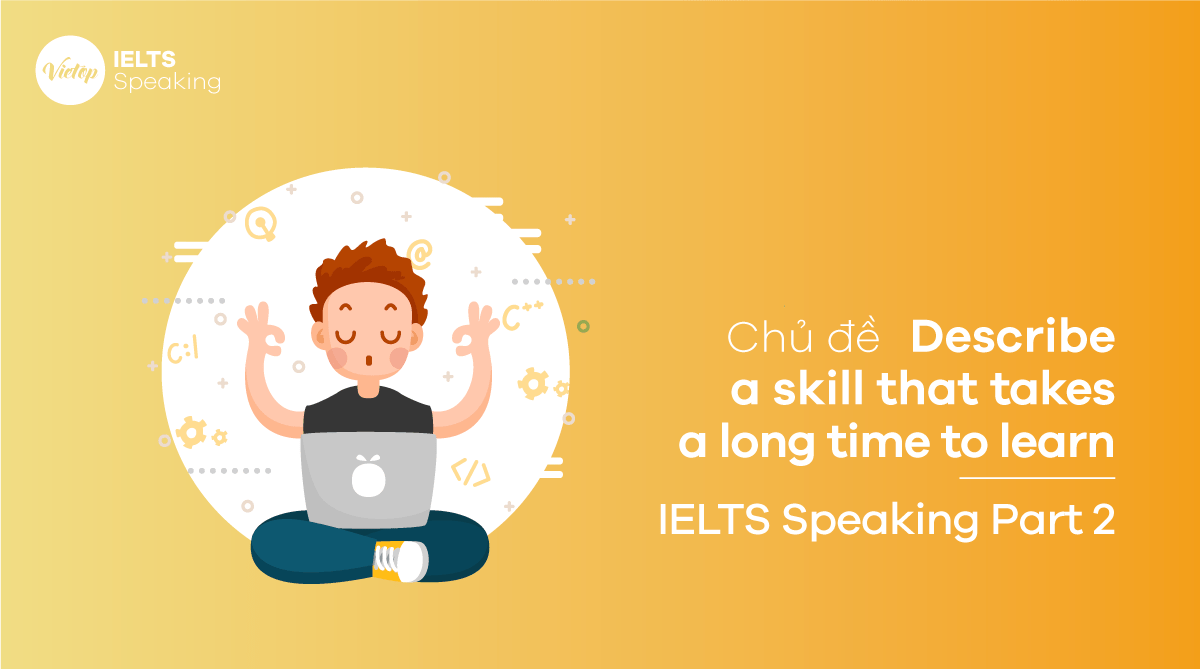Chủ đề Describe a skill that takes a long time to learn là một trong những chủ đề có khả năng cao xuất hiện trong bài thi IELTS Speaking part 2, 3 vậy bạn đã có ý tưởng gì cho bài nói chủ đề này chưa?
IELTS Vietop sẽ giới thiệu đến bạn môt bài mẫu thú vị, hy vọng bạn sẽ nắm được cách tìm idea và cách trả lời tốt nhất nhé.
1. Một số lưu ý ở chủ đề Describe a skill that takes a long time to learn
- Aspect: Để nói đủ thời gian quy định, ngoài việc dựa vào các câu hỏi gợi ý của mỗi chủ đề, bạn luôn cần ghi nhớ các câu hỏi/ các ý như how, where, when, who, why, what, purpose, feelings để có thể mở rộng câu trả lời của mình.
- Structure: Cách để cấu trúc 1 bài nói về mô tả 1 kỹ năng mà bạn đã/ đang/ muốn học là kể 1 câu chuyện. Bạn nên nói tình trạng/ cảm xúc/ tình huống của bạn xảy trước khi học kỹ năng đó, trong khi học và sau khi học.

Nhận tư vấn miễn phí khóa học hè
2. Bài mẫu chủ đề Describe a skill that takes a long time to learn – IELTS Speaking part 2

Describe a skill that takes a long time to learn
You should say:
- What the skill is
- How useful that skill is in our daily life
- Why it takes a long time to learn
2.1. Sample 1
Mời bạn cùng nghe Podcast bài mẫu Part 2 của IELTS Vietop nhé:
Well actually, deciding which skill takes more time to learn is up to a learner; how much he dedicated, hard-work, determined for learning a particular field. However, based on my experience, painting is really time-consuming to learn.
[Before learning] I have always been keen to learn how to draw and paint since I was a child. However, back then, I had to go to many supplementary classes and join other activities outside schools. Not until I entered to university did that desire ignite again. [While learning: why it is hard and how I feel] I decided to sign up a class of watercolor painting which is later, I found out is the hardest.
First, I need to get to know all the relevant theories involving types of papers, brushes and colors then some basic techniques. They do not sound complicated at all but once you start painting, it is anything but easy. The hardest part for me is to get familiar with holding the brushes. If I held it too loose, colors would be smudged and ruins other details. But if I held it too tight, it would take forever to finish. Another struggle is controlling the amount of color or water because of special color spillage of watercolor.
There are no formula or scales, so the key here is that I have to practice almost non-stop to be accustomed to it. Perhaps because I’m not gifted but it is known that one painting needs around 3 hours to be finished. It means that learning to paint requires a great level of attention and enthusiasm. At first, I feel frustrated and wanted to give up but thanks to each finished picture I painted, I feel that all my hard work and effort paid off.
[After learning: how it is useful and how I feel] After studying painting for nearly 3 months, I realized that it not only trains me to be more patient and determined, but it is also a way of relaxing when I play with multiple shades of colors. Also, now I can paint and give those paintings as presents to my friends on special occasions.
They all love it because of its uniqueness and the love I put in. I really think learning painting is one of the best decisions I have ever made, and I think I’m gonna learn drawing portrait if I have time, though it also takes a considerably longer period of time to master.
Dịch:
Thực ra, việc quyết định kỹ năng nào cần nhiều thời gian hơn để học là tùy thuộc vào người học; anh ấy đã cống hiến, chăm chỉ, quyết tâm học một lĩnh vực cụ thể như thế nào. Tuy nhiên, theo kinh nghiệm của tôi, việc học vẽ thực sự tốn rất nhiều thời gian.
[Trước khi học] Tôi luôn thích học vẽ và tô màu từ khi còn nhỏ. Tuy nhiên, hồi đó tôi phải đi học thêm nhiều lớp và tham gia các hoạt động ngoài trường. Mãi đến khi vào đại học, niềm khao khát đó mới bùng cháy trở lại. [Trong khi học: tại sao nó khó và cảm giác của tôi] Tôi quyết định đăng ký một lớp vẽ màu nước, lớp học vẽ màu nước sau này tôi mới biết là lớp vẽ khó nhất.
Đầu tiên, tôi cần tìm hiểu tất cả các lý thuyết liên quan đến các loại giấy, bút vẽ và màu sắc, sau đó là một số kỹ thuật cơ bản. Chúng nghe có vẻ không phức tạp chút nào nhưng một khi bạn bắt đầu vẽ thì mọi việc thật dễ dàng.
Phần khó nhất đối với tôi là làm quen với việc cầm cọ. Nếu tôi giữ nó quá lỏng, màu sắc sẽ bị nhòe và làm hỏng các chi tiết khác. Nhưng nếu tôi giữ nó quá chặt, sẽ mất rất nhiều thời gian để hoàn thành. Một cuộc đấu tranh khác là kiểm soát lượng màu hoặc nước vì màu nước bị đổ màu đặc biệt.
Không có công thức hay thang âm nào nên mấu chốt ở đây là mình phải luyện tập gần như không ngừng nghỉ để làm quen với nó. Có lẽ vì tôi không có năng khiếu nên người ta biết rằng một bức tranh phải mất khoảng 3 giờ mới hoàn thành. Điều đó có nghĩa là việc học vẽ đòi hỏi sự chú ý và nhiệt tình cao độ. Lúc đầu tôi thấy nản và muốn bỏ cuộc nhưng nhờ mỗi bức tranh vẽ xong tôi cảm thấy mọi sự cố gắng, nỗ lực của mình đã được đền đáp.
[Sau khi tìm hiểu: nó hữu ích như thế nào và tôi cảm thấy thế nào] Sau khi học hội họa gần 3 tháng, tôi nhận ra rằng nó không chỉ rèn luyện tôi tính kiên nhẫn và quyết tâm hơn mà còn là một cách thư giãn khi tôi chơi với nhiều sắc thái của màu sắc. Ngoài ra, bây giờ tôi có thể vẽ và tặng những bức tranh đó làm quà cho bạn bè trong những dịp đặc biệt.
Tất cả họ đều yêu thích nó vì sự độc đáo của nó và tình yêu mà tôi dành cho. Tôi thực sự nghĩ rằng học vẽ là một trong những quyết định đúng đắn nhất mà tôi từng đưa ra và tôi nghĩ mình sẽ học vẽ chân dung nếu có thời gian, mặc dù điều đó cũng mất thời gian. một khoảng thời gian dài hơn đáng kể để thành thạo.
Vocab highlights
- Dedicated (a): cống hiến
- Hard-work (a): chăm chỉ
- Determined (a): quyết tâm
- Time-consuming (a): tốn thời gian
- Keen to: hào hứng với…
- Desire: khao khát
- Ignite: thắp lên, nhen nhóm lên
- Be anything but: là bất kỳ điều gì trừ…
- Get familiar with: quen với
- Loose (a): lỏng lẻo
- Smudged: bị lem
- Ruin (v): hủy hoại
- Tight (a): chặt
- Take forever: tốn quá nhiều thời gian, gần như không bao giờ xong
- Struggle (n, v): khó khăn phải vượt qua
- Special color spillage: độ loang màu đặc biệt
- Formula: công thức
- Scales: tỉ lệ
- Be accustomed to: quen với
- Gifted (a): có khiếu
- Frustrated (a): hụt hẫng, thất vọng
- Paid off: được đền đáp
- Special occasions: những dịp đặc biệt
- Uniqueness: sự độc nhất
- Enthusiasm (n): sự hứng thú
- A great level of: mức độ cao về…
Xem thêm một số bài viết cùng chuyên mục:
2.2. Sample 2
Mời bạn cùng nghe Podcast bài mẫu Part 2 của IELTS Vietop nhé:
Today, I’d like to share my journey of acquiring a skill that required a considerable amount of time to master: cooking Western dishes.
Several years ago, I tuned in to the TV show “Master Chef US,” and I found myself captivated by the distinctive world of Western cuisine and the remarkable culinary skills of the chefs. I deeply admired their ability, wishing I could cook Western dishes just as proficiently.
Determined to embark on this culinary adventure, I invested in all the essential kitchen equipment and gathered the necessary ingredients to begin my journey into the realm of Western cooking.
Admittedly, Western cuisine demanded a different set of cooking techniques and treatment of specific ingredients. Initially, I dedicated a significant amount of time to memorizing the names of signature ingredients like basil, butter, and cheese, along with the methods of combining them harmoniously.
The cooking process itself was also time-consuming. In contrast to Vietnamese cuisine, each Western dish typically required a specific sauce, prompting me to start with the most straightforward sauce recipes.
Furthermore, I had to learn how to effectively use the oven. I became proficient in making perfect toasts and mastering the incorporation of milk and butter into various dishes. These were culinary skills I had never imagined I’d acquire, such as utilizing red wine in cooking or preparing raw dishes. In conclusion, I can now proudly prepare delicious and nourishing Western dishes for my family, in addition to my proficiency in Eastern cuisine.
While cooking may appear effortless on television and seemingly quick, the journey to mastering this skill is genuinely challenging when the goal is to create perfect dishes.
Dịch:
Hôm nay, tôi muốn chia sẻ hành trình học được một kỹ năng đòi hỏi nhiều thời gian để thành thạo của mình: nấu các món ăn phương Tây.
Cách đây vài năm, tôi xem chương trình truyền hình “Master Chef US” và thấy mình bị cuốn hút bởi thế giới ẩm thực phương Tây đặc sắc cũng như kỹ năng nấu nướng vượt trội của các đầu bếp. Tôi vô cùng khâm phục khả năng của họ, ước gì mình cũng có thể nấu món Tây thành thạo như vậy.
Quyết tâm dấn thân vào cuộc phiêu lưu ẩm thực này, tôi đã đầu tư vào tất cả các thiết bị nhà bếp thiết yếu và thu thập những nguyên liệu cần thiết để bắt đầu hành trình bước vào thế giới nấu ăn phương Tây. Phải thừa nhận rằng ẩm thực phương Tây đòi hỏi một loạt kỹ thuật nấu ăn và cách xử lý các nguyên liệu cụ thể khác nhau.
Ban đầu, tôi dành một khoảng thời gian đáng kể để ghi nhớ tên các nguyên liệu đặc trưng như húng quế, bơ, phô mai cùng với phương pháp kết hợp chúng một cách hài hòa.
Bản thân quá trình nấu ăn cũng tốn nhiều thời gian. Ngược lại với ẩm thực Việt Nam, mỗi món ăn phương Tây thường yêu cầu một loại nước sốt cụ thể, điều đó thôi thúc tôi bắt đầu với những công thức nấu nước sốt đơn giản nhất.
Hơn nữa, tôi phải học cách sử dụng lò nướng một cách hiệu quả. Tôi trở nên thành thạo trong việc nâng cốc chúc mừng hoàn hảo và thành thạo việc kết hợp sữa và bơ vào nhiều món ăn khác nhau.
Đây là những kỹ năng nấu nướng mà tôi chưa bao giờ tưởng tượng mình sẽ có được, chẳng hạn như sử dụng rượu vang đỏ trong nấu ăn hoặc chế biến các món ăn sống. Tóm lại, giờ đây tôi có thể tự hào chuẩn bị những món ăn ngon và bổ dưỡng của phương Tây cho gia đình mình, bên cạnh khả năng thông thạo ẩm thực phương Đông của mình.
Mặc dù việc nấu ăn có vẻ dễ dàng và nhanh chóng trên truyền hình nhưng hành trình để thành thạo kỹ năng này thực sự là một thử thách khi mục tiêu là tạo ra những món ăn hoàn hảo.
Xem thêm:
- Describe a picture
- Describe a part of your country that you find interesting
- Describe a shop that you enjoy going to
3. Bài mẫu Describe a skill that takes a long time to learn – IELTS Speaking part 3

Mời bạn cùng nghe Podcast bài mẫu Part 3 của IELTS Vietop nhé:
3.1. Why does it take a lot of time to learn a skill?
In my view, the learning process for acquiring a new skill typically spans an extended period. This extended timeframe is necessary because it allows our brains and bodies to adjust to the demands of the new skill.
For instance, consider learning to play the guitar. It requires a considerable amount of time for the muscles in your hands and fingers to develop the agility and precision needed to move swiftly and accurately, enabling you to press the correct strings at the right locations to produce the desired guitar sounds.
Essentially, the duration of the learning curve is dictated by the need for our brains and bodies to acclimate to the intricacies of the new skill. However, it’s important to note that the pace of adaptation can vary among individuals for different skills.
- A new skill typically spans: một kỹ năng mới thường kéo dài
- Bodies to adjust: cơ thể để điều chỉnh
- Precision: độ chính xác
3.2. Is it important to learn a new skill?
Absolutely. I believe that life is a continuous journey of learning. Therefore, if you’re not actively acquiring and honing new skills, you might not be pushing your own boundaries, and life could become somewhat monotonous. To lead a truly fulfilling life, I think it’s essential to consistently embrace the opportunity to acquire new skills.
- Boundaries: ranh giới
- Monotonous: đơn điệu
3.3. What do people feel when they have to wait?
Well, it’s a matter of individual differences, I suppose. Some people naturally possess more patience than others, and as a result, they may feel quite comfortable when faced with waiting times.
Conversely, individuals who tend to be more impatient can become quite frustrated when confronted with extended waiting periods. Ultimately, the level of comfort or frustration largely hinges on the nature of what they are waiting for and the duration of the wait.
- Frustrated: bực bội
3.4. What do young people and old people do while waiting?
Well, it seems that younger individuals often occupy their waiting time by fixating on their smartphones, scrolling through their Facebook feed or engaging with various apps. On the other hand, older generations tend to engage in conversations with each other, discussing topics like the weather or reading the news. To be honest, I’m not entirely certain about the specific activities older individuals prefer during waiting periods.
- Fixating on: cố định trên
- Engaging: hấp dẫn
3.5. What type of skills may take a long time to learn?
Mastering skills such as calligraphy, which is considered a Chinese art form, is a time-consuming endeavor. It demands consistent practice, meticulous training, and keen observation.
In fact, virtually every skill necessitates training and patience. Many skills require a degree of dexterity, making it essential for individuals to invest substantial time and effort in order to attain a high level of proficiency.
- Meticulous: tỉ mỉ
- Proficiency: khả năng
3.6. Why would people spend a lot of time learning one skill?
Some individuals are deeply passionate about their hobbies and aspire to achieve mastery in their pursuits. Consequently, they dedicate significant time to learning and honing these skills that bring them joy. Conversely, there are certain skills for which children may not exhibit a natural aptitude. Nevertheless, these skills still hold value and should be learned to some extent, even if it takes longer to acquire proficiency.
- Mastery: sự làm chủ
- Honing: mài giũa
- Natural aptitude: năng khiếu bẩm sinh
Xưm thêm bài mẫu Speaking:
- Bài mẫu topic Environment IELTS Speaking Part 1, 2, 3
- Bài mẫu topic work and study IELTS Speaking part 1
- Bài mẫu topic Morning time – IELTS Speaking part 1
Bài mẫu topic Environment IELTS Speaking Part 1, 2, 3
3.7. Do people feel happy after they have learned a new skill?
Absolutely, there’s a profound sense of achievement and happiness associated with creating something new. Learning a new skill often brings joy to most people. Even basic activities like cooking, sewing, or knitting can offer immense happiness when attempted for the first time.
- Profound: thâm thúy
- Immense: bao la
3.8. Do you think it takes a long time to learn a language?
The capacity to acquire a new language can differ significantly from one person to another. Certain individuals exhibit a remarkable ability to grasp new vocabulary swiftly, whereas others may encounter challenges in the process. Obtaining a basic understanding of any language may not be too demanding, but achieving fluency requires a considerable amount of time and effort.
- Remarkable: đáng chú ý
- Encounter: bắt gặp
Vừa rồi, IELTS Vietop cũng đã chia sẻ bài mẫu Describe a skill that takes a long time to learn – IELTS Speaking part 2, 3. Bạn có thể xem thêm nhiều bài mẫu chủ đề khác ở chuyên mục IELTS Speaking do các giảng viên Vietop chia sẻ nhé!
Chúc các bạn học tốt! Và nếu vẫn chưa có phương pháp học IELTS hiệu quả thì hãy nhanh tay liên hệ để Vietop hỗ trợ bạn nhé!











